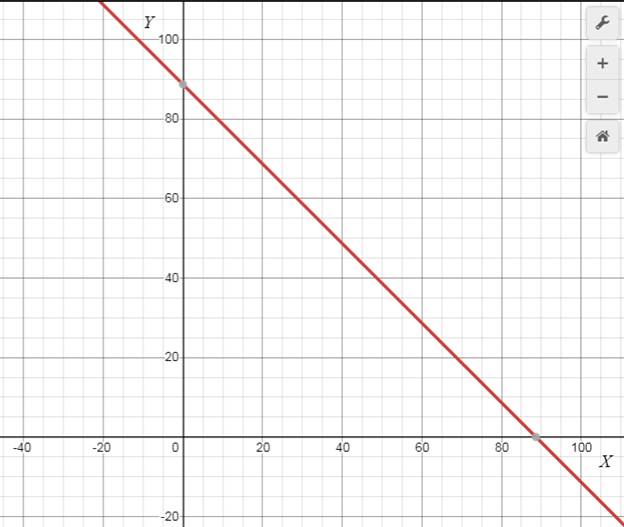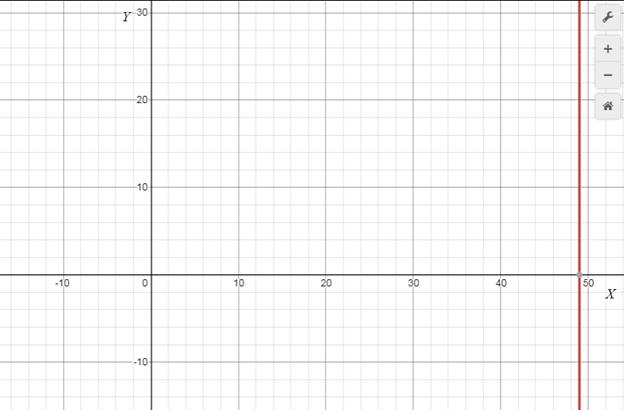
Concept explainers
a.
Calculate the linear equation of the line giving the demand x in terms of the rent p .
a.
Answer to Problem 96E
The linear equation of the line is
Explanation of Solution
Given:
It is given in the question that a real state office handles an apartment complex with
Concept Used:
In thise,use the concept of umderstanding the different variable and constant to make the linear equation and also use the slope formula i.e,
Calculation: In this ,first it has to be find the slope for the linear equation .now,looking at the two points it gives us,
So by the given slope ,it means that for every
Now,it’s time to create a equation but apart from that it has to keep in mind that
Conclusion:
The equation is
b.
Draw the graph of the equation obtained in part (a) and also Find the number of units occupied when the rent is
b.
Answer to Problem 96E
The number of units occupied is
Explanation of Solution
Given:
It is given in the question that the expression obtained from part (a) is
Concept Used:
In this, use the concept of graphical analysis and use the expression to put the value on that and find the solution.
Calculation:
The graph of the equation is given below:

Now,the equation is
Put
Conclusion:
The number of unit occupied is
c.
Find the number of units occupied when the rent is lowered to
c.
Answer to Problem 96E
The number of units accupied is
Explanation of Solution
Given:
It is given in the question that the expression is
Concept Used:
In this, use the concept of putting the value in the expression and find the solution and also known to draw the graph.
Calculation: Now,the equation is
Put
The graph for this is also given below:

Conclusion:
The number of units occupied is
Chapter 1 Solutions
Precalculus with Limits: A Graphing Approach
- × Question 2 ▾ Score on last try: 0 of 1 pts. See Details for more. > Next question You can retry this question below Find two positive numbers x and y such that x + y = 14 and they minimize x² + y². x = Уarrow_forwardSup the is a -12 -10 -8 -6 -4 -2 16 Af(x) 8 -8- -16arrow_forwardThe function f is given by f(x) = cos(x + 1). The solutions to which 6 of the following equations on the interval 0≤ x ≤ 2 are the solutions to f(x) = 1½ on the interval 0 < x < 2π? 2 A √√3 cos x - sin x = 1 B √√3 cos x + sin x = 1 C √3 sin x COS x = 1 D √√3 sin x + cos x = 1arrow_forward
- Suppose that the graph below is the graph of f'(x), the derivative of f(x). Find the locations of all relative extrema, and tell whether each extremum is a relative maximum or minimum. Af'(x) Select the correct choice below and fill in the answer box(es) within your choice. (Simplify your answer. Use a comma to separate answers as needed.) -10 86-4-2 -9- B 10 X G A. The function f(x) has a relative maximum at x= relative minimum at x = and a B. The function f(x) has a relative maximum at x= no relative minimum. and has C. There is not enough information given. D. The function f(x) has a relative minimum at x= no relative maximum. and has E. The function f(x) has no relative extrema.arrow_forwardK Find the x-values of all points where the function has any relative extrema. Find the value(s) of any relative extrema. f(x) = 12x+13x 12/13 Select the correct choice below and, if necessary, fill in any answer boxes within your choice. OA. There are no relative maxima. The function has a relative minimum of (Use a comma to separate answers as needed.) OB. There are no relative minima. The function has a relative maximum of (Use a comma to separate answers as needed.) OC. The function has a relative maximum of at x= (Use a comma to separate answers as needed.) OD. There are no relative extrema. at x= at x= and a relative minimum of at x=arrow_forwardK Find the x-values of all points where the function has any relative extrema. Find the value(s) of any relative extrema. f(x) = - 2 3 9 -4x+17 Select the correct choice below and, if necessary, fill in any answer boxes within your choice. OA. There are no relative minima. The function has a relative maximum of (Use a comma to separate answers as needed.) OB. There are no relative maxima. The function has a relative minimum of (Use a comma to separate answers as needed.) OC. The function has a relative maximum of at x= (Use a comma to separate answers as needed.) OD. There are no relative extrema. at x= at x= and a relative minimum of at x=arrow_forward
- K Find the x-values of all points where the function defined as follows has any relative extrema. Find the values of any relative extrema. f(x)=5x+ In x Select the correct choice below and, if necessary, fill in the answer boxes to complete your choices. OA. There is a relative minimum of OB. There is a relative maximum of OC. There is a relative minimum of OD. There are no relative extrema. at x= at x= at x= There is a relative maximum of at x=arrow_forward21-100 Spring 2024 Fin gra 10 8 Ay -10 -B -2 -4- -6 -8- -10- 10 re xamp OK CH acer USarrow_forwardThe total profit P(X) (in thousands of dollars) from a sale of x thousand units of a new product is given by P(x) = In (-x+6x² + 63x+1) (0≤x≤10). a) Find the number of units that should be sold in order to maximize the total profit. b) What is the maximum profit? a) The number of units that should be sold in order to maximize the total profit is ☐ (Simplify your answer.)arrow_forward
- Find the x-values of all points where the function has any relative extrema. Find the value(s) of any relative extrema. f(x) = -x3+3x² +24x-4 Select the correct choice below and, if necessary, fill in any answer boxes within your choice. OA. There are no relative maxima. The function has a relative minimum of at x= (Use a comma to separate answers as needed.) OB. The function has relative minimum of at x= and a relative maximum of at x= (Use a comma to separate answers as needed.) OC. There are no relative minima. The function has a relative maximum of (Use a comma to separate answers as needed.) OD. There are no relative extrema. at x=arrow_forwardcan you solve this question step by step with detail explaination pleasearrow_forwardcan you solve this question step by step with detail explaination pleasearrow_forward
 Calculus: Early TranscendentalsCalculusISBN:9781285741550Author:James StewartPublisher:Cengage Learning
Calculus: Early TranscendentalsCalculusISBN:9781285741550Author:James StewartPublisher:Cengage Learning Thomas' Calculus (14th Edition)CalculusISBN:9780134438986Author:Joel R. Hass, Christopher E. Heil, Maurice D. WeirPublisher:PEARSON
Thomas' Calculus (14th Edition)CalculusISBN:9780134438986Author:Joel R. Hass, Christopher E. Heil, Maurice D. WeirPublisher:PEARSON Calculus: Early Transcendentals (3rd Edition)CalculusISBN:9780134763644Author:William L. Briggs, Lyle Cochran, Bernard Gillett, Eric SchulzPublisher:PEARSON
Calculus: Early Transcendentals (3rd Edition)CalculusISBN:9780134763644Author:William L. Briggs, Lyle Cochran, Bernard Gillett, Eric SchulzPublisher:PEARSON Calculus: Early TranscendentalsCalculusISBN:9781319050740Author:Jon Rogawski, Colin Adams, Robert FranzosaPublisher:W. H. Freeman
Calculus: Early TranscendentalsCalculusISBN:9781319050740Author:Jon Rogawski, Colin Adams, Robert FranzosaPublisher:W. H. Freeman
 Calculus: Early Transcendental FunctionsCalculusISBN:9781337552516Author:Ron Larson, Bruce H. EdwardsPublisher:Cengage Learning
Calculus: Early Transcendental FunctionsCalculusISBN:9781337552516Author:Ron Larson, Bruce H. EdwardsPublisher:Cengage Learning





